
About UsThe Numismatic Bibliomania Society is a non-profit organization promoting numismatic literature. For more information please see our web site at coinbooks.org SubscriptionsThose wishing to become new E-Sylum subscribers (or wishing to Unsubscribe) can go to the following web page link MembershipThere is a membership application available on the web site Membership Application To join, print the application and return it with your check to the address printed on the application. Membership is only $15 to addresses in the U.S., $20 for First Class mail, and $25 elsewhere. For those without web access, write to: David M. Sundman, Secretary/TreasurerNumismatic Bibliomania
Society AsylumFor Asylum mailing address changes and other membership questions, contact David at this email address: dsundman@LittletonCoin.com SubmissionsTo submit items for publication in The E-Sylum, just Reply to this message, or write to the Editor at this address: whomren@coinlibrary.com
BUY THE BOOK BEFORE THE COINYou won't regret it! |
- WAYNE'S WORDS: THE E-SYLUM SEPTEMBER 28, 2008
- SKLOW OCTOBER 4, 2008 NUMISMATIC LITERATURE SALE CATALOG NOW ONLINE
- FANNING OCTOBER 28, 2008 NUMISMATIC LITERATURE SALE CATALOG NOW ONLINE
- NEW BOOK: EARLY PAPER MONEY OF AMERICA BY ERIC NEWMAN (5TH EDITION)
- BOOK REVIEW: 2009 STANDARD CATALOG OF WORLD COINS 2001-DATE
- BOOK REVIEW: I'M CHET, THE AUTOBIOGRAPHY OF CHET KRAUSE
- PHOTO ASSISTANCE NEEDED FOR WHITMAN'S U.S. PAPER MONEY ENCYCLOPEDIA
- MORE ON NUMISMATIC BOOK ODDITIES: ISBNS AND TITLES
- FIRE PROMPTS EVACUATION OF DENVER MINT
- MYSTERY CHINESE COIN THEORY: PART OF AN IMPORTED BASKET?
- THOUGHTS ON THE 1876 CENTENNIAL C.A.G.E MEDAL MYSTERY
- J.N.T. LEVICK PHOTO THEORY
- MORE ON THE MOST POPULAR PORTRAITS ON COINS AND MEDALS
- WHEN IS BOIS DURCI NOT BOIS DURCI?
- COUNTERFEIT KING'S HISTORY CHANNEL SEGMENT
- MORE ON EBAY PAYMENT POLICIES
- MORE "YOU MIGHT BE A NUMISMATIC BIBLIOPHILE IF..."
- QUERY: THE MOST EXPENSIVE NEW NUMISMATIC BOOK
- QUERY: INFORMATION ON 1858 U.S. MINT CABINET ROBBERY SOUGHT
- THOUGHTS ON THE NEW LINCOLN CENT REVERSE BICENTENNIAL DESIGNS
- PLAN AHEAD FOR THE FEBRUARY 2009 LINCOLN BICENTENNIAL
- MONUMENT DEDICATED TO JEFFERSON NICKEL DESIGNER FELIX SCHLAG
- TENNESSEE'S CASHVILLE GOLD COIN TREASURE HUNT A SUCCESS
- COUNTERFEIT ONE POUND COINS APPEARING IN SHEFFIELD, ENGLAND
- SPINK TO AUCTION MILLION POUND BANKNOTE
- NEW COIN ART FORM IN AMSTERDAM
- ESCHEWING BANKS, MAN STOCKPILED COINS TO BUY A TRUCK
- FEATURED WEB SITE: THE LEWES POUND
WAYNE'S WORDS: THE E-SYLUM SEPTEMBER 28, 2008
 Among our recent subscribers are Ken Hill
and Don Marsh, courtesy of Tom Sheehan, Larry DeBellis and Mike
Samaskeawicz, courtesy of Bob Neale, Stan Moore, Martin Kaplan, Ian Jones,
Jon Radel, Rick Stroman and Thomas Wetter. Welcome aboard! We now have
1,201 subscribers.
Among our recent subscribers are Ken Hill
and Don Marsh, courtesy of Tom Sheehan, Larry DeBellis and Mike
Samaskeawicz, courtesy of Bob Neale, Stan Moore, Martin Kaplan, Ian Jones,
Jon Radel, Rick Stroman and Thomas Wetter. Welcome aboard! We now have
1,201 subscribers.This week we open with updates on the upcoming October numismatic literature sales from David Sklow and David Fanning. Next, we have the announcement of a new edition of Eric Newman's classic work on U.S. colonial paper money, and reviews of the new 2009 Standard Catalog of World Coins 2001-Date and I'm Chet.
Responses to earlier discussions encompass a wide range of topics, including numismatic book oddities and bois durci. New queries involve the most expensive numismatic book and the robbery of the U.S. Mint coin collection in 1858.
In the news, a fire forces the evacuation of the U.S. Mint in Denver, Co., counterfeit one-pound coins flood England, and Spink is auctioning a one million pound banknote. To learn where to find 300,000 euro cents lying loose in the streets, read on. Have a great week, everyone!
Wayne Homren
Numismatic Bibliomania Society
SKLOW OCTOBER 4, 2008 NUMISMATIC LITERATURE SALE CATALOG NOW ONLINE
Some Sale highlights include: Newell, Robert & Son. (ORIGINAL) PHOTOGRAPH OF YE OLDE MINT IN PHILADELPHIA, PA. Philadelphia, Pa. Sepia tone 197mm x 246mm {7 13/16 x 9 > inches}, Rare 1929 ANA Convention Photograph. Scarce ANA 1944 Auction & Convention Program, A long run of over One Hundred Thomas Elder catalogues. The first twenty-five numbered Steigerwalt Auction catalogues, U.S. Mint at Philadelphia by James Rankin Young, 1903 rare bound edition, Lincoln Medals by Robert P. King, an original manuscript, Phillips 1865-1866 Historical Sketches of the Paper Currency of the American Colonies #48 of 250.
An original 1875 Crosby, Early Coins of America, The Allison Jackman/Clarence Beckwith Sales by Henry Chapman, specially bound with plates from the original glass negatives, De Knight's scarce History of the Currency, 2nd edition 1900, A long run of monograph reprints from The Numismatist, some very rare & unique dating back to 1893, Rare correspondence of Byron F. Johnson, Several original manuscripts and trial copies on tokens by Author James J. Curto, Rare Volume 5 of The Numismatist 1892, Rare Catalogues of the Dr. Richard Mead Collection 1754-1755, Newcomb 1801-02-03 U.S. Large Cents, 1st edition Redbook, complete set of The Asylum.
FANNING OCTOBER 28, 2008 NUMISMATIC LITERATURE SALE CATALOG NOW ONLINE
One note: The PDF version of the catalogue does not include the bidsheet, which states that we are charging the customary 15% buyers premium. Bidders will be reminded of this when bidding over the phone or by e-mail, but please keep it in mind. We will try to post an updated PDF soon that makes this clear.
NEW BOOK: EARLY PAPER MONEY OF AMERICA BY ERIC NEWMAN (5TH EDITION)
Indeed, the 5th edition of The Early Paper Money of America has finally arrived at our offices here in Iola and will soon be available for sale on our website and through numismatic book dealers.
The new edition offers some excellent improvements, including many color images, countless text revisions, updated and expanded note values from Stuart Levine encompassing the highest grades currently available and more. This nearly 500 page hardcover is essential to any numismatic library for it's comprehensive coverage of American Colonial Paper Money. The cover price is $95.00, but if stock arrives soon, interested buyers can take advantage of the current 15% discount offered for KP Books throughout October 14th.
Kudos really need to be extended to all the folks involved in bringing this 5th edition to market. It was a massive task that carried on for several years and we have these people to thank for it's completion:
Eric P. Newman - for his enthusiasm and expansive research and updates
Stuart Levine - for his vast and highly accurate updating of market values
Kara Grundman - for her outstanding efforts at designing a comfortably flowing reference work
George Cuhaj - for his expert assistance in acquiring and processing color images
and last, but not least,
Randy Thern - for his dedication and perseverance in guiding this book project through several years of internal company changes
Thanks for bringing a great new edition of this classic reference work back to the Early American market!
To read the complete blog post, see: New 5th Edition Colonial Paper Money Book (http://blog.numismaticnews.net/ideas/New+5th+
Edition+Colonial+Paper+Money+Book.aspx)
BOOK REVIEW: 2009 STANDARD CATALOG OF WORLD COINS 2001-DATE
 This week I took at look at the 3rd edition of
Krause Publications' 2009 Standard Catalog of World Coins 2001-Date
(3rd edition). The 432-page 8.5"x11" softbound catalog follows the
standard format of the SCWC series - three columns of listings per page,
ordered alphabetically by country. Every (or nearly every) coin type is
illustrated in black and white, and each country section begins with a map
showing the country's location.
This week I took at look at the 3rd edition of
Krause Publications' 2009 Standard Catalog of World Coins 2001-Date
(3rd edition). The 432-page 8.5"x11" softbound catalog follows the
standard format of the SCWC series - three columns of listings per page,
ordered alphabetically by country. Every (or nearly every) coin type is
illustrated in black and white, and each country section begins with a map
showing the country's location.To gauge the completeness of the catalog, I first checked the United States section. Sure enough, every circulating and commemorative design from 2001 to date is shown, including every state quarter, the Presidential dollars, and bullion pieces through the one ounce platinum coins.
Flipping through the pages gives a quick lesson in world geography and politics. There are many countries that didn't exist when I started collecting world coins as a kid, and many of the countries that existed back then are there no longer. Who knew where Nauru is?
What a challenge it would be to assemble a collection of 21st century coinage using this catalog as a guide! I think one would have to be quite the world traveler or know several people who are. These modern coins are largely the pocket change of today, with little value to incent dealers to stock them. Am I wrong? Is there a dealer or specialty organization that seeks out and distributes these coins to collectors?
I enjoyed flipping through the catalog. Some of my favorite designs were those of Slovakia, which I thought were elegantly simple and beautifully executed.
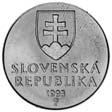
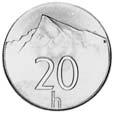
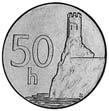
I also enjoyed Great Britain's circulating commemorative fifty pence coins, which I remember from my time in London last year. My favorite is the Samuel Johnson piece showing text from Johnson's English dictionary: "Fifty" and "Pence". Viewing the catalog I saw a design I never came across in circulation, the Victoria Cross piece, unusual in that it's a coin depicting a medal. Are there any other such designs?
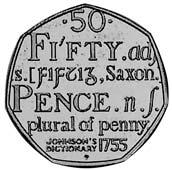

Accompanying the catalog is a DVD containing all 432 pages in a single whopping Adobe .pdf file. Adobe Reader proves fairly quick and easy navigation through the catalog, with predefined bookmarks for every country, arrows to page back and forth, and a search function. For those of us who glaze over reading the fine print, pages and images on the DVD can be enlarged 400%.
All in all, the book and DVD are a very useful package.
BOOK REVIEW: I'M CHET, THE AUTOBIOGRAPHY OF CHET KRAUSE
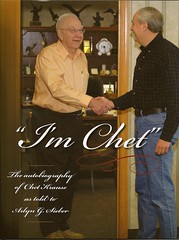 The E-Sylum recently had a notice about a book
- I'm Chet, The Autobiography of Chet Krause as told to Arlyn G.
Sieber. Since the 1970s, Chet and I have been introduced and met many
times but only for a handshake. Then somehow I was sitting at the same
table with him at a ANA Convention and thought I could have a conversation
with him, but so did about twenty other people. I have always wanted to
know more about him, so I quickly decided to order the book.
The E-Sylum recently had a notice about a book
- I'm Chet, The Autobiography of Chet Krause as told to Arlyn G.
Sieber. Since the 1970s, Chet and I have been introduced and met many
times but only for a handshake. Then somehow I was sitting at the same
table with him at a ANA Convention and thought I could have a conversation
with him, but so did about twenty other people. I have always wanted to
know more about him, so I quickly decided to order the book.About ten days later, an 8 1/2 x 11 inches size hardbound book arrived with 208 pages and a nice color dust cover. I was nicely surprised to see Chet had autographed the title page to me. I am very sure he did not do it because I am special to him, but that he is autographing all of them.
The first 40 pages are about his pre-WWII life growing up on a farm in a close knit family and community. I remember my Grandfather Daniel calling them "The Good Ole Days." There were many little things that he was taught and experienced that became important things in his later life. Hard work and being an honest and good man were the most important.
Two of his brothers went off to war before him. Learning to be a mechanic and welder in his young life guided him during his wartime service into doing the same work in an Army Anti-Aircraft unit. His traveling on troop ships reminded me of my one trip from Germany back to the USA. Ugh! His family was very lucky to have all three sons return from WWII without a scratch. Besides mechanic and welder training as a young man, Chet also learned carpentry. He created a construction business and built many houses and other buildings. While this business kept him busy during the day, he started a numismatic publishing business with Numismatic News at night. He kept both going until it was too much and he decided numismatics was his future and dropped the construction business.
His personal collecting also advanced after WWII into more US coins and Wisconsin notes, but he also has collections of WWI Liberty Bonds and WWII War Bonds. Then he attended his first ANA Convention in 1956 and has been attending them ever since.
There are many employees and (business and personal) friends mentioned along in his numismatic business life, but the most prominent is Cliff Mishler. They made excellent business partners and Cliff was someone he gladly handed the business down to when he retired the first of several times. It does not seem that any of his many friendships were one-sided. They were all good for Chet and his friends.
I have met people all over the world ask me if I know him. Since I used to write a lot for his numismatic and philatelic periodicals and still update his world catalogs, I surely must be very close to him in their minds. I do wish I was closer to him but I have had the privilege of working with many of the good people he hired to work at Krause Publications. After reading this book, I know he surrounded himself with only good people like himself, so I do feel like I do know him very well.
You can order the book for $20.00 plus $5.00 shipping by sending a check payable to the Iola Historical Society. Their address is P.O. Box 252, Iola, WI 54945-0252.
THE BOOK BAZARRE
PHOTO ASSISTANCE NEEDED FOR WHITMAN'S U.S. PAPER MONEY ENCYCLOPEDIA
From the publisher:
Dave Bowers writes:
This list has a lot of esoterica among the higher denominations, but there are quite a few 20th century small-size I can use. Need color scans 400 dpi to 1200 dpi. Can receive at my private e-mail at qdbarchive@metrocast.net if no more than 2MB per transmission (separate transmissions are fine), or on a CD (will reimburse postage): Dave Bowers, Box 539, Wolfeboro Falls, NH 03896.
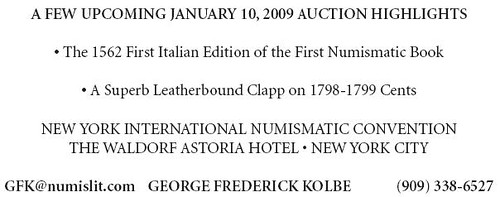
MORE ON NUMISMATIC BOOK ODDITIES: ISBNS AND TITLES
Regarding the topics raised by David Lange, Alan Roy writes:Now, a book with three very different titles: 1980, Tannahill, Cecil, An Illustrated Edition on Banking, Trade Tokens, Paper Money & Scrip Used in the Territory and Province of Saskatchewan (from the title page) or Saskatchewan Trade Tokens, Paper Money, Scrip (front cover), or Saskatchewan Numismatica (from the spine). Always confusing when I see it in a for-sale list.
FIRE PROMPTS EVACUATION OF DENVER MINT
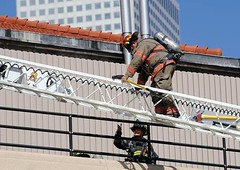 Employees at the Denver Mint were evacuated
after smoke filled the ventilation system early this afternoon.
Employees at the Denver Mint were evacuated
after smoke filled the ventilation system early this afternoon.
Guillermo Hernandez, chief of public affairs for the Mint, said that at about 1:40 p.m., smoke was noticed on the floor of the main press room.
Hernandez said workers in the room - where coins are pressed - triggered the fire alarm, and the entire day shift of 120 people was evacuated.
Some welding or grinding was going on involving one of the machines on the main floor press room, Hernandez said, and some of the sparks were sucked into the nearby exhaust system, starting a fire.
He said fire fighters had to climb to the second floor of the Mint and shoot water down the air duct system.
Although fire fighters were able to put out the fire within a few minutes, Hernandez said that an extensive water cleanup is involved.
To read the complete article, see: Fire prompts evacuation of Denver Mint (http://www.denverpost.com/ci_10567376)
MYSTERY CHINESE COIN THEORY: PART OF AN IMPORTED BASKET?
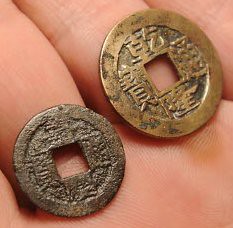 Regarding last week's E-Sylum item about the
Chinese coin recently discovered at a New York archeological site, Dick
Doty writes:
Regarding last week's E-Sylum item about the
Chinese coin recently discovered at a New York archeological site, Dick
Doty writes:
THOUGHTS ON THE 1876 CENTENNIAL C.A.G.E MEDAL MYSTERY
Ron Abler writes: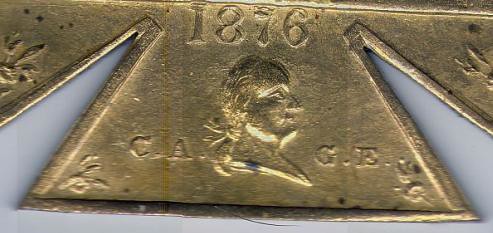
J.N.T. LEVICK PHOTO THEORY
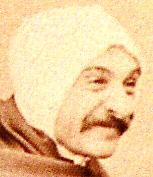 Regarding the unusual photo of J.N.T. Levick
sent in by Jim Neiswinter, Alan V. Weinberg writes:
Regarding the unusual photo of J.N.T. Levick
sent in by Jim Neiswinter, Alan V. Weinberg writes:
MORE ON THE MOST POPULAR PORTRAITS ON COINS AND MEDALS
Recently Dick Johnson asked, "Whose portrait has appeared on coins and medals more than any other?"Bob Neale writes:
I ran Bob's question past Dick Johnson, who writes:
WHEN IS BOIS DURCI NOT BOIS DURCI?
For the benefit of our new subscribers, I'll provide some background here. In earlier issues we discussed a material called Bois Durci (meaning "hardened wood") which had been used to create medals that look very similar to bronze.Philip Mernick writes:
I don't know who made them or when but I have seen copies of several different plaques in brass and iron. They are usually fairly weakly moulded so presumably were derived from a Bois Durci plaque rather than the original dies. They use both sides of the plaque hence the "Bois Durci" wording on the back.
We have a pair of lead squeezes of Queen Victoria & Prince Albert that must have been taken from actual Bois Durci dies because they are so sharp.

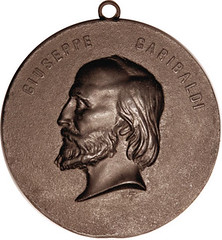

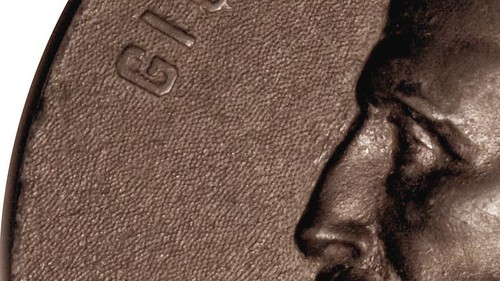

COUNTERFEIT KING'S HISTORY CHANNEL SEGMENT
Jim writes:
MORE ON EBAY PAYMENT POLICIES
Regarding the question of the eBay's violation of antitrust laws, Larry Gaye writes:Jeff Starck writes:
eBay Changes Search, Bans Money Orders And Checks (http://www.auctionbytes.com/cab/cab/abn/y08/m08/i20/s03)
eBay Sellers Cope With Changes (Again) (http://www.auctionbytes.com/cab/cab/abn/y08/m08/i21/s01)
Guide to eBay Changes (http://www.auctionbytes.com/cab/cab/abu/y208/m08/abu0221/s03)
A link at both stories directs readers to eBay's actual announcement which, if read entirely, makes it clear what is going on. (http://www2.ebay.com/aw/core/200808200704212.html)
A more detailed look at the changes (http://pages.ebay.com/sell/August2008Update/Overview/)
MORE "YOU MIGHT BE A NUMISMATIC BIBLIOPHILE IF..."
Richard Margolis writes:
So who will be the first to send us a photo of their numismatic library? -Editor
QUERY: THE MOST EXPENSIVE NEW NUMISMATIC BOOK
Which brings us to Len's question about the issue price of numismatic books:
To read the full list, see: Ten Most Expensive Art Books Sold in 2008 (http://www.abebooks.com//docs/RareBooks/10-expensive
-art-Aug08.shtml?cm_ven=nl&cm_cat=nl&cm_pla=cme_cme_Art08&cm_ite=readlist)
QUERY: INFORMATION ON 1858 U.S. MINT CABINET ROBBERY SOUGHT
John Dannreuther writes:In fact, I just used the site to find details of the 1858 Mint robbery. Although some details are included (the Templeton Reid $25 is not specifically mentioned, but a $25 coin was stolen and it was the only $25 coin in the collection), it was a general article repeating a Philadelphia newspaper story. Also, a $40 bar was stolen. The report did not say why the coins were not recovered, although the two culprits were almost immediately captured after trying to spend one of the twenties stolen in the robbery.
Do any of our readers have a more detailed account of what was stolen and what was recovered?
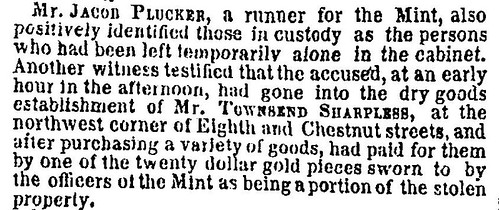
THE BOOK BAZARRE
THOUGHTS ON THE NEW LINCOLN CENT REVERSE BICENTENNIAL DESIGNS
Those noble outlines grasp,
But childhood.s chubby fingers
The image oft will clasp.
The poor man will esteem it,
And mothers hold it dear .
The plain and common people
He loved when he was here.
. .The Lincoln Cent,.
The New York Sun, February 1909
This poem from the year the Lincoln Cent made its appearance speaks volumes of the veneration and affection that was held for both the great and humble man, "Father Abraham" and the coin, the lowly but noble cent that bears his likeness.
It is fitting that Lincoln is associated most closely to the cent, each humble in origin and aspect but indelible as icons of our civilization. After all, the Lincoln cent is the most reproduced object of art in all of human history.
The first oil painting I ever made at the tender age of eight, on a little 6"x8" canvass board was of Abraham Lincoln from a Matthew Brady portrait reproduced in our family encyclopedia.
As a professional artist and illustrator I have had occasion to depict Lincoln numerous times, on book covers and postage stamp designs. Never could I have dreamed that the arc of my personal and professional story would intersect such a momentous combination of events: those being, President Theodor Roosevelt's selection of Victor David Brenner's profile of Lincoln, the first president to appear on a circulating coin for the centennial celebration of his birth and five score later, to have my design candidate for the third aspect of Lincoln's life, his professional years in Illinois, appear on the reverse for the 2009 Bicentennial celebration.
At a later date I would like to expand on the research and design process which I found so rewarding and enlightening. The more I read of Lincoln, especially contemporary accounts, the more profound my respect and affection for this great leader grew. For now, allow me to reiterate my deep gratitude and sense of humility and honor to be connected to the recognition of one of our greatest Presidents along with the other artists and sculptors, Victor David Brenner, Frank Gasparro, Richard Masters, Charles Vickers, Don Everhart, Susan Gamble and Joseph Menna, who have added their creativity to this icon of American coinage.
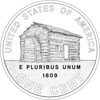
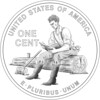
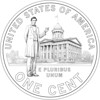
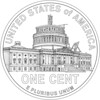
ILLINOIS ARCHITECT PRODDED MINT TO USE OLD STATE CAPITOL ON NEW CENTS
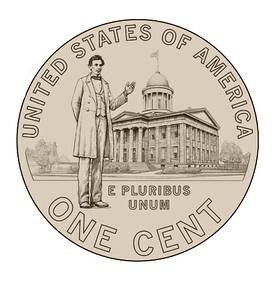 Earl Wallace Henderson doesn.t give up
easily.
Earl Wallace Henderson doesn.t give up
easily.As a fledgling architect, .Wally. Henderson designed the restoration of the Old State Capitol in the 1960s, when skeptics said it couldn.t be done.
Now, 40 years later, Henderson has triumphed again. Thanks to him, the building he saved will appear on millions of commemorative pennies due to be issued next year.
Given the choice between a penny featuring Lincoln holding a book or Lincoln standing outside the Old State Capitol, the director of the U.S. Mint went with the book last spring. Lots of insiders didn.t like it.
The decision, disclosed to a committee of the national Abraham Lincoln Bicentennnial Commission in May, was supposed to be final.
.Our committee was disappointed, but how can you fight the U.S. government?. committee member Julie Cellini wrote in an e-mail to The State Journal-Register. .So everyone pretty much gave up. Everyone except Wally..
The more Henderson thought, the angrier he got. After all, the penny was supposed to depict Lincoln.s years in Illinois.
.I wake up in the middle of the night saying, .This is the most ridiculous (expletive) thing I.ve ever seen,.. Henderson recalled. .This could be anybody in the world looking at Playboy magazine anywhere in the world. It had nothing to do with Illinois..
Appropriately, it was June 6 . D-Day . when Henderson had his first showdown with the mint. It came during a conference call with a mint official who was supposed to brief committee members on the planned coins.
.The mint representative is some woman who comes on strong . wouldn.t let you get a word in edgewise,. Henderson recalled. .I finally got a word in edgewise. She said, .It.s impossible . once we.re on track, we can.t reverse this thing.. I was really riled up. I could have strangled her.
.There was only one way to get it done, and that was to go over her head..
Treasury Secretary Henry Paulson was the only person who could overrule the director of the mint. Henderson started making calls and writing letters, waxing eloquent and enlisting support from such heavies such as U.S. Rep. Ray LaHood, R-Peoria, and U.S. Sen. Dick Durbin, D-Illinois.
A penny might not be worth much, but it is forever . and almost everyone in the nation has at least one, Henderson said in his pitches.
.He talked about how civilizations come and go, but their coins remain, thousands of years later, that coins survive floods and fires and wars,. wrote Cellini, who sits on the state and national Lincoln bicentennial commissions and so heard Henderson.s plea twice. .Each time I heard his argument, it seemed stronger. More important. Worth fighting for..
Henderson convinced the bicentennial commissions, which wrote letters to Paulson asking that the decision be reversed. He also swayed Durbin, pointing out that Henderson had been appointed to an advisory committee that.s helping shape the observance of the 200th anniversary of Lincoln.s birth.
.I said, .You asked me to be an adviser . I.m advising you that they.re screwing Illinois with this coin,.. Henderson said.
Durbin, who refers to Henderson as .my buddy,. called Paulson personally.
.I said, .I.ve got to ask you a favor,.. Durbin recalled. .He said he.d think about it. He called me back and said, .Some people will be unhappy with me, but I.m going to do it..
.Wally Henderson deserves the credit for inspiring me,. Durbin said.
Officially, the credit goes to the national Lincoln bicentennial commission, so far as the mint is concerned.
But those who saw Henderson at work think otherwise.
To read the complete article, see: Architect urged mint to employ good cents (http://www.sj-r.com/homepage/x1836508700/
Architects-fight-gets-Old-State-Capitol-on-Lincoln-coin)
PLAN AHEAD FOR THE FEBRUARY 2009 LINCOLN BICENTENNIAL
- The National Opening Ceremony - Louisville, Kentucky and Hodgenville, Kentucky.
- The Mother's Day Celebration - Lincoln City, Indiana.
- A Dedication Day Ceremony in Gettysburg, Pennsylvania
- Lincoln Birthday Celebration in Washington, D.C.
- The Lincoln Memorial Rededication Series - Washington, D.C.
- Joint Meeting of Congress at Statuary Hall.
Other tributes slated for the next two years include:
- A redesigned 2009 cent series and five dollar bill.
- A 2009 bicentennial commemorative dollar coin.
- Four commemorative Lincoln stamps.
- Town Hall meetings in ten different cities.
- A week-long Lincoln Bicentennial Bike Tour, Tour de Lincoln, from August 16-23, 2008 which begins at Lincoln's birthplace in Hodgenville, Kentucky and concludes in Springfield, Illinois.
- A Lincoln Poetry Evening in Washington, D.C. - September 22, 2008.
- A nationally televised .Teach-in. for students and teachers on February 12, 2009.
- A global conference at Oxford University - July 3-5, 2009. An international symposium in Paris, France.
An example of a local event is by the Putnam Museum in Davenport, Illinois. It is planning a full day for kids age 7 to 11 in the Quad City area. For February 15 they are planning "Penny Science" in honor of Lincoln's 200th and the Lincoln cent's 100th. There will be, according to their announcement, "games and hands-on activities featuring trivia and amazing experiments with that common copper coin." Whatever your plans, tell it to the Abraham Lincoln Bicentennial Commission at www.lincolnbicentennial.gov/contact-us.aspx
They want to learn of everything that honors Lincoln and the Lincoln cent. Tell 'em. For the Putnam Museum announcement, click on: Explore science at the Putnam (http://qconline.com/archives/qco/display.php?id=406282)
MONUMENT DEDICATED TO JEFFERSON NICKEL DESIGNER FELIX SCHLAG
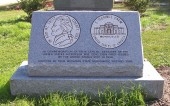 Torrential rain kept about 25 people huddled in
a tent Sept. 14 at a ceremony to dedicate a grave side monument to
Jefferson nickel designer Felix Schlag at the Oak Hill Cemetery in Owosso,
Mich., says Steve Bieda, designer of the stone.
Torrential rain kept about 25 people huddled in
a tent Sept. 14 at a ceremony to dedicate a grave side monument to
Jefferson nickel designer Felix Schlag at the Oak Hill Cemetery in Owosso,
Mich., says Steve Bieda, designer of the stone.Emcee of the event was Dave Andreas, vice president and treasurer of the Jefferson Full Step Nickel Club.
Unveiling the stone was Schlag's daughter, Hilda Schlag Hein, and two granddaughters.
To read the complete article, see: Schlag Monument Dedicated (http://www.numismaster.com/ta/numis/Article.jsp?
ad=article&ArticleId=5353)
TENNESSEE'S CASHVILLE GOLD COIN TREASURE HUNT A SUCCESS
 Mandy Claiborne never imagined that she and
friend John "Bip" Burage would walk away with $500 at the end of Cashville
Gold & Silver Buyers' citywide treasure hunt.
Mandy Claiborne never imagined that she and
friend John "Bip" Burage would walk away with $500 at the end of Cashville
Gold & Silver Buyers' citywide treasure hunt.The pair had searched for the coin for five days in Centennial Park before they found it.
"I felt so silly out there picking up rocks and looking in odd places," said Claiborne, a Sylvan Park resident. "It was funny the day we actually found it, because we'd looked in the area before, just not in the particular spot it was hidden."
The $500 value gold-replica coin was hidden under the bridge in the Sunken Garden at Centennial Park, where people often get married.
"There must have been at least 70 people, if not more, at the park that day looking for this coin," Claiborne said. "I didn't think we'd find it because everyone was so focused. They were everywhere."
Nearby, Julie Schoerke, owner of the JKS Communications public relations firm and one of the event organizers, watched the scene play out.
She remembers the moment when the last clue was released on the Cashville Web site.
"All of these people were on cell phones, it turns out with people at home at computers waiting for the last clue, and other people were sitting in cars in the parking lots at Centennial Park with laptops refreshing the page until the clue came up," she said. When it did come up, "we heard yelling and people started running . ... It was just kind of wild to see everybody descend, all ages, all socioeconomic backgrounds, on this little area."
Cashville Gold & Silver Buyers, in the Davidson County town of Berry Hill, launched its inaugural treasure hunt early last month.
Josh Levine, Cashville's president, said he took a half-ounce gold USA Eagle coin, made it into a replica and hid it in Centennial Park. The winner could choose to keep the real coin or trade it in for $500.
To read the complete article, see: Friends team up to win gold coin treasure hunt (http://www.tennessean.com/apps/pbcs.dll/article?
AID=/20080922/NEWS01/809220329/1006)
To read the previous E-Sylum article, see: TREASURE HUNT: A TWIST ON THE OLD COIN DROP PUBLICITY PLOY (http://www.coinbooks.org/club_nbs_esylum_v11n33.html#article27)
COUNTERFEIT ONE POUND COINS APPEARING IN SHEFFIELD, ENGLAND
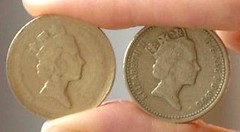 Crooks are trying to sell bags of counterfeit
cash on the streets of Sheffield, The Star can reveal today. The
revelation comes after the Royal Mint revealed the amount of forged coins
in circulation has doubled in five years.
Crooks are trying to sell bags of counterfeit
cash on the streets of Sheffield, The Star can reveal today. The
revelation comes after the Royal Mint revealed the amount of forged coins
in circulation has doubled in five years. George Glover, chairman of the Moor Market Federation, said stallholders have been approached by people selling bags of fake #20 coins for #13 - and telling them to pass on to unsuspecting customers as change.
He said market traders often have problems checking whether coins are genuine because scrutinising each one would cause hold-ups for customers and lose them business.
Coin collector Trevor Lovett, from Barnsley, was handed a poor-quality fake pound coin as change in a Sheffield city centre pub.
He said: "If you check your change immediately, you can refuse it, but after that, there is very little you can do.
"You can identify fakes easily, however, because of their poor quality, different weight and, with mine, the Queen's head and design on the opposite side were not the matching way up."
Mr Lovett has kept his as a memento but police have warned that people are committing a criminal offence if they try to pass them on.
Insp Neil Mutch, who is in charge of Sheffield city centre safer neighbourhood team, added: "Anyone offered bags of fake coins should report it - we would like to hear information about large-scale counterfeiting.
"Anyone who finds they have been given a fake #1 coin should be aware that passing it on is an offence and the appropriate action is to take it into a bank."
The results of a sampling test by the Royal Mint showed that nationwide, up to two per cent of all the pound coins in circulation may be fake - approximately 30 million coins and double the level of five years ago.
Robert Matthews, formerly the Queen's Assay Master until he retired to become a coin consultant four years ago, said confidence in coins collapsed in other countries when forgery rates reached similar levels.
To read the complete article, see: City's fake coins alert (http://www.sheffieldtelegraph.co.uk/news2/
Fake-coins-alert.4531645.jp)
SPINK TO AUCTION MILLION POUND BANKNOTE
A rare UK bank note for one million pounds is set to sell at auction for #40,000, but it is not the bargain it first appearsThere have only ever been nine #1,000,000 notes produced and only two remain ... but you shouldn't take it at face value.
They were issued by the Treasury on August 30, 1948 in connection with the Marshall Aid Plan after World War II and were intended for internal use as 'records of movement' for a period of six weeks only.
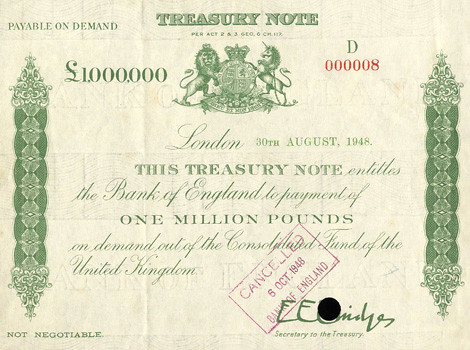
A spokesperson for Spink, the specialist auctioneers, who will sell the note on October 1 said: "It is believed that nine examples were produced and only two, Numbers Seven and Eight, survived.
"The two notes were given as mementoes to the respective U.S. and U.K. Treasury Secretaries. The Number Seven was first sold in 1977 and is listed in the Guinness Book of Records as being the highest denomination note in private hands.
"The Number Eight note is dated 30 August 1948. It bears the signature of E. E. Bridges in the lower right hand corner and is cancelled over the signature and stamped 6 October 1948, Bank of England."
To read the complete article, see: #1,000,000 banknote to sell for #40,000 (http://newslite.tv/2008/09/26/1000000-banknote
-to-sell-for-4.html)
NEW COIN ART FORM IN AMSTERDAM
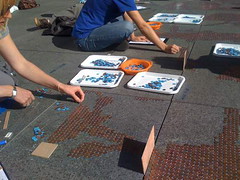 There is a new coin art form on exhibit in
Amsterdam. It is laying coins loosely in artistic patterns on the ground
of a large plaza. Part of the coins spell out the slogan "Obsessions make
my life worse and my work better." The remainder of some 300,000 euro cent
denomination coins are arranged in calligraphic form with floral
embellishments.
There is a new coin art form on exhibit in
Amsterdam. It is laying coins loosely in artistic patterns on the ground
of a large plaza. Part of the coins spell out the slogan "Obsessions make
my life worse and my work better." The remainder of some 300,000 euro cent
denomination coins are arranged in calligraphic form with floral
embellishments. The art work is the creation of Stefan Sagmeister for an event called the Biennale 2008 in celebration, it appears, of urban living. It bears the theme "Space and Place, Design for the Urban Landscape."
After all, the organizers are eager to point out that cities are home to over half the world's population. Further cities are a metaphor for today's cultures and a testing ground for new forms of conviviality and interaction.
A news article doesn't say how long it took a team of eight to form the design in coins. Each coin was painstakingly positioned within the 20 x 42 meter area.
They are well aware it is money lying on the ground. Will viewers leave the art work intact because of its beauty? Will they take the coins and create their own design in response to the work? Or will greed take over and the coins gradually disappear?
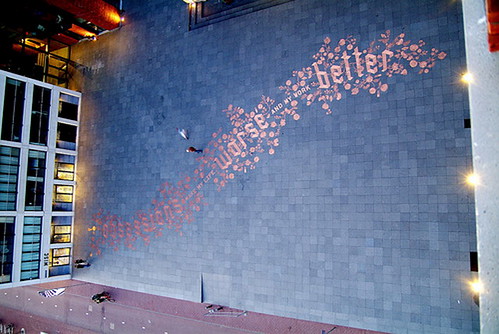
You can view the pictures on the following web site. The first illustration is on a wall, the others are on the "Coins Road."
To read the complete article, see: 300,000 Euro Cent Coins Road (http://www.joubonjala.com/forum/photos-arts/
65185-300-000-euro-cent-coins-road.html)
ESCHEWING BANKS, MAN STOCKPILED COINS TO BUY A TRUCK
Joseph D. McCarthy writes:The owner, a retired engineer, said he stockpiled several rolls of coins, since he didn't trust banks, and could lose paper money in a fire. Apparently his wife didn't share his concerns about banks, she wrote a cheque to cover the balance of the cost."
Joe adds:
2. Then again, looking at the Banks on the Stock Market, maybe he knew something.
FEATURED WEB SITE: THE LEWES POUND
This week's featured web site on The Lewes Pound is recommended by John N. Lupia III.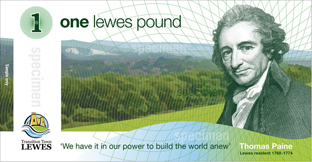
www.thelewespound.org/
